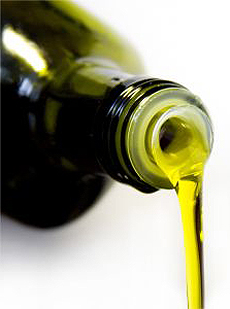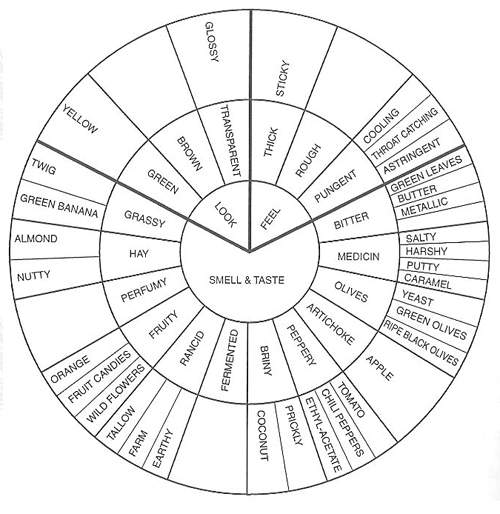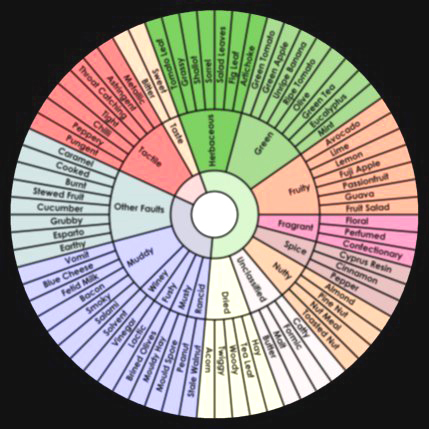
 Do you prefer your olive oil green and grassy or pungent and peppery? An olive oil wheel helps you to identify the many flavors and aromas. Photo by Pawel Kryj | SXC.
|
KAREN HOCHMAN is Editorial Director of THE NIBBLE.
|
|
November 2005
Last updated May 2010
|
 |
The Olive Oil Wheel
The Aromas & Flavors of Olive Oil
CAPSULE REPORT: Based on the Wine Aroma Wheel, which clearly articulates the flavors and aromas of wine, there are two “olive oil wheels”: the Mojet Wheel and the Recognose Wheel. They demystify the complex flavor and aroma components of olive oil, and are extremely helpful aids in identifying the particular flavors and styles that you like. Then, you can tell your merchant that you’re looking for a grassy oil, a peppery oil, a fruity oil, etc.
Overview
In the early 1980s, the Wine Aroma Wheel was developed by Professor Ann C. Noble of the University of California at Davis. It provided a common vocabulary for discussing what one smells (and subsequently, encounters on the palate) in a wine. It groups similar aromas into “families,” and it enables beginners to quickly get a perspective of a very complex topic. (You can purchase one at WineAromaWheel.com.)
This brilliant tool inspired olive oil experts to developed analogous wheels to explain the sensory components of virgin olive oil. They are very useful to make sense of the many different flavors and aromas of the different olive oils themselves, and the different olives that produce them.
Mojet Wheel
In 1993, at the Proceedings of the Symposium on Sensory and Nutritional Quality of Extra Virgin Olive Oil in Milan, J. Mojet and S. de Jong* presented a paper on “The Sensory Wheel: A Proposal for Standard Reference of Virgin Olive Oil Sensory Evaluation.”
*In academic fashion, first names are were not attached to the reference source and we were unable to find them elsewhere.
The Sensory Wheel divided 50 different descriptors into three categories to analyze: appearance, mouthfeel, and smell/taste:

Recognose Wheel
The Sensory Wheel was a good start, but a more advanced and complex tasting wheel was developed by Richard Gawel, leader of the Australian Olive Association Tasting Panel. It lists 72 different terms that can better used to describe the complex range of aromas and tastes found in virgin olive oils. The terms fall into the main olive oil sensory classes of herbaceous, fruity, fragrant, spicy, nutty, dried, defects, tactile and taste. Their selection was based on how frequently experienced olive oil tasters are perceived to use them, as well as their occurrence in the olive oil tasting literature.
Gawel explains that some descriptors such as “buttery,” “nutty” and “grassy,” are commonly used in that they define many oil styles. Others are varietal-based. For example:
- The Tuscan cultivar Frantoio yields a “perfumed” aroma
- The Spanish cultivars Picual and Nevadillo Blanco are associated with the aroma of “tomato leaf”
- Some oils made from the Italian cultivar Leccino yield a malt-like character
Still others are descriptive of imperfect oils.
- Some very ripe oils have the colorful but not-too-pleasant scents of “cat wee” and “crushed ant” or formic acid.
- Twenty-five of the terms describe defects in the oil. Flavors of toffee or caramel in olive oil are defects in the “burnt” category; flavors of salami, smoke, or bacon are “muddy” defects. They may be welcome flavors elsewhere, but they don’t belong in olive oil.
You’ll never look at olive oil the same way again!

A laminated version of the chart, approximately 16.5" x 11.6", is available from The Aroma Dictionary for about $23.00, which includes shipping. You can download a free PDF list of descriptors in chart form (not the wheel) at the Aroma Dictionary website under Resources.
Master the concept, and you’ll be surprised at how the seeming unconquerable vastness of the olive oil category suddenly begins to make sense.
Lifestyle Direct, Inc. All rights reserved. Images are the copyright of their individual owners.

|




 Do you prefer your olive oil green and grassy or pungent and peppery? An olive oil wheel helps you to identify the many flavors and aromas. Photo by Pawel Kryj | SXC.
Do you prefer your olive oil green and grassy or pungent and peppery? An olive oil wheel helps you to identify the many flavors and aromas. Photo by Pawel Kryj | SXC. 
